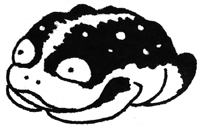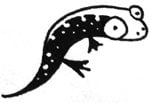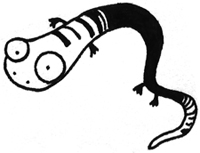Hope for the Axolotl: On the Amphibian Extinction Crisis by Lydia K. '14, MEng '16
Happy Save the Frogs Day!
Today is the fifth annual Save The Frogs Day, a day to spread awareness about the amphibian extinction crisis. When I was in high school I used to spend this day at my little brother’s elementary school with my pet frogs and a powerpoint presentation. This year I’m sharing with you an essay I wrote two years ago. Some research has happened since then, and I encourage you to Google and PubMed for updates (and please post what you found in the comments for the rest of us to see). I hope you enjoy and I hope you learn something new.
One of the strangest, most opportune gifts I’ve gotten was a small plastic aquarium, from one of my best friends, on my sixth birthday. Misha had scrawled his name on the card, but you could tell it was one of those disappointing educational gifts that was actually picked out by the parents.
 I found it almost a year later in my closet, full of beads and wrapped in a pink feather boa. In a bout of the
I found it almost a year later in my closet, full of beads and wrapped in a pink feather boa. In a bout of the  haphazard enthusiasm characteristic of that age, I dumped the beads on the floor and filled the aquarium with tap water and a bag of bright blue aquarium sand I found under the sink. That evening my parents bought me two aquatic frogs (both male).
haphazard enthusiasm characteristic of that age, I dumped the beads on the floor and filled the aquarium with tap water and a bag of bright blue aquarium sand I found under the sink. That evening my parents bought me two aquatic frogs (both male).
The bulk of my childhood was defined by those frogs. I spent hours every week watching them eat and swim in the mornings before my parents woke up. After my little brother was born we curled up next to their aquarium and watched them together, and when they died seven years later I had trouble falling asleep without their singing.

The Axolotl
Since then I’ve branched out, extending my love for frogs to amphibians in general. My favorite amphibian today is the axolotl, because it eschews the very first characteristic we’re taught to associate with the class. Most amphibians are born in the water, metamorphose into their adult forms, and crawl out onto the land, not to return to their home ponds, streams, or lakes until they’re ready to lay their own eggs. The axolotl, on the other hand, never leaves its aquatic birthplace. In fact, it forgoes metamorphosis altogether, retaining its larval characteristics even as it reaches sexual maturity. Consequently the axolotl possesses for life not only its characteristic feathery external gills, but also unique regenerative powers.
In humans and most other species, cells are trapped in their final forms after they differentiate. But because the axolotl does not metamorphose, its cells are capable of reverting to a state similar to stem cells, prefatory cells that can develop into anything. Rather than plaster wounds with scar tissue like we do, the axolotl rebuilds injured tissue. The result is like new.

 Amazingly, these abilities extend well beyond the level of tissues: the axolotl is capable of regenerating entire limbs, even when they include parts of the spinal cord and the neurons inside it, and even parts of the brain. Since the 1960s, the axolotl has been studied in hopes of understanding its regenerative powers and applying them to other organisms—perhaps even humans. The axolotl is, in essence, the closest thing in nature to a fountain of youth.
Amazingly, these abilities extend well beyond the level of tissues: the axolotl is capable of regenerating entire limbs, even when they include parts of the spinal cord and the neurons inside it, and even parts of the brain. Since the 1960s, the axolotl has been studied in hopes of understanding its regenerative powers and applying them to other organisms—perhaps even humans. The axolotl is, in essence, the closest thing in nature to a fountain of youth.
Unfortunately, the days of the axolotl and any secrets it hides are numbered. Of the two Mexico City lakes the wild axolotl once persisted in, one, Lake Chalco, has been drained to subdue flooding, destroying the axolotls and other animals within it. The other, Lake Xochimilco, has been reduced to a heavily polluted system of canals and small lakes fed by water treatment plants. Axolotls exist in six isolated areas of the former Lake Xochimilco, mostly clumped around the few remaining natural springs.
When the Aztecs began building Mexico City, Lakes Chalco and Xochimilco were a system of five large groundwater-fed lakes. The axolotl was prevalent in Aztec culture, ubiquitous in food, in cultural ceremonies, and in medicine.
Today, Mexico is home to 375 identified amphibian species, making it the country with the fifth greatest amphibian diversity. At the same time, Mexico City is home to 18 million people, making it the third largest metropolitan area in the world. In the past two decades, the wild population of the axolotl has fallen sixtyfold. Today there are estimated to be between 700 and 1,200 axolotls in the wild.
The primary threat to axolotls is habitat loss and the degradation of what little habitat remains. Pollution from Mexico City corrupts water quality, and UV-B radiation, caused by the degradation of the ozone layer, weakens young axolotls, making them more susceptible to predators and to disease. In addition, at least ten species of nonnative fish have been introduced into Lake Xochimilco. These invasive species have substantial niche overlap with the axolotls to compete with them for food and to eat their eggs and young. Human exploitation for food and medicine, meanwhile, is no longer a concern, as axolotls are scarce enough to be a rare catch for fishermen.

The Amphibian

 The threat of imminent extinction looms over other amphibian species as well. Three summers ago, biologists from the University of the Andes in Colombia used a combination of genetics and almost a decade of field work to discover 11 new amphibian species in Panama, only to find that five were extinct by the time they were identified. In the past decade, 40% of amphibian species at the El Cope national park in Panama have disappeared.
The threat of imminent extinction looms over other amphibian species as well. Three summers ago, biologists from the University of the Andes in Colombia used a combination of genetics and almost a decade of field work to discover 11 new amphibian species in Panama, only to find that five were extinct by the time they were identified. In the past decade, 40% of amphibian species at the El Cope national park in Panama have disappeared.
At 300 million years old, amphibians are the oldest four-legged vertebrates on Earth. Since the 1970s, however, they have been in decline. Today, according to the International Conservation of Nature (IUCN) Red List, an inventory of all known species’ conservation statuses, 2.1% of known amphibian species are extinct, 32.5% are threatened with extinction, and 43% are declining.

 Threats to amphibians mirror those to the axolotl. Like the axolotl, other amphibians also suffer from habitat loss, pollution, exploitation by humans, and competition from invasive species. In addition, over 2800 amphibian species are threatened by the chytrid fungus, a deadly pathogen that kills up to 80% of amphibians within a year of being introduced and is spreading at a rate of 28 to 100 kilometers a year.
Threats to amphibians mirror those to the axolotl. Like the axolotl, other amphibians also suffer from habitat loss, pollution, exploitation by humans, and competition from invasive species. In addition, over 2800 amphibian species are threatened by the chytrid fungus, a deadly pathogen that kills up to 80% of amphibians within a year of being introduced and is spreading at a rate of 28 to 100 kilometers a year.
Even the fungus can be traced to human influence. Many researchers believe that a warmer climate favors the propagation of chytrid, and that the current outbreaks are due to warmer temperatures, though this is controversial. Less debated is that recent changes in amphibian habitat, from climate change to urbanization, cause enough stress to compromise the amphibian immune system, making it more vulnerable to chytrid. Worse, disease transmission increases with diversity loss. As amphibian diversity vanishes, susceptibility to chytrid will only increase.
One trait that makes amphibians particularly valuable to us is their skin. Amphibians depend on their skin for everything from breathing to hydration to self-defense. Their thin, permeable skin gives them an especially intimate connection with the world around them, which includes the water they are born in, the land they live on, and the air they breathe. Because amphibians are especially sensitive to toxins and other harmful changes in the environment, they are often considered indicators of their habitat’s health. When trouble strikes, amphibians are often the first to go.
And, indeed, trouble has struck. According to the IUCN Red List, almost 20% of vertebrate species are currently classified as threatened by extinction. Some, including nature writer David Quammen, worry that if present trends continue, the Earth will fall into a mass extinction comparable to those in Ordovician, Devonian, Permian, Triassic, and Cretaceous periods, characterized by a loss of over 75% of species. This was confirmed by a study published in Nature in 2011. Recent patterns—”multiple, atypical high-intensity ecological stressors, including rapid, unusual climate change and highly elevated atmospheric CO2″—mirror those of past mass extinctions, say the authors of the study.

Certain Doom?
When I was in middle and high school, my parents and I used to canoe to the most sordid section of the muddiest marsh we could find. We put the stickiest seaweed in a Tupperware container where it lived, undisturbed, on my bedside table.
Slowly, critters hatched out from the murk. All variety of creatures crawled out of the stagnant mess to explore. Usually the mosquitoes dominated the ecosystem. Tiny dots darted through the leaves and each other, growing into frenzied black clouds until finally the Tupperware was a thick fog of mosquito.

 Suddenly, after weeks, it stopped. The water dirtied and all life—the jumpers and the swimmers and the crawlers and, finally, the champion mosquitoes—vanished.
Suddenly, after weeks, it stopped. The water dirtied and all life—the jumpers and the swimmers and the crawlers and, finally, the champion mosquitoes—vanished.

Luckily for the axolotl, the probability of its extinction in present circumstances is low. A 2007 study by the National Autonomous University of Mexico determined that the population, while small, is stable. Furthermore, the 2011 Nature study warning of a sixth mass extinction concluded that the current loss of world biodiversity does not yet amount to one.
However, the same study that concluded that axolotls are safe also noted that their population consists primarily of one-year-olds—though axolotls can live up to 17 years in captivity—because pressure from predators and insufficient habitat kill most axolotls at a young age. The study concludes that a small reduction in egg and larvae survival rate increases the calculated probability of extinction within the next 20 to 50 years to 100%.
The same goes for the rest of the world. According to the 2011 Nature study, the extinction of those species currently marked as critically endangered would be enough to pull us irretrievably into a sixth mass extinction. After the species currently marked as endangered and vulnerable go extinct, the loss of biodiversity corresponding to a mass extinction will take only several centuries, orders of magnitude faster than the typical two million years. Our world would soon be unrecognizable.

Possible Solutions
 According to the 2007 study by the National Autonomous University of Mexico, the best options for saving
According to the 2007 study by the National Autonomous University of Mexico, the best options for saving the axolotl are to restore their habitat to a state more conducive to the survival of eggs and young. This includes improving the quality of water, extricating foreign fish, and re-establishing Lake Xochimilco as more than a series of canals. Current efforts revolve around building axolotl “sanctuaries” in Lake Xochimilco, in which the axolotl are separated from the invasive fish by wooden gates. Another option, reintroduction (freeing lab-raised axolotl populations into the wild), has been considered but rejected, for fear of spreading chytrid fungus to and reducing the genetic diversity of the wild population. The possibility of introducing healthy captive populations into the wild has similarly been considered for saving other amphibian populations, but cautiously. In one case, the reintroduction of the Majorcan midwife toad introduced chytrid to the island of Majorca, infecting the reintroduced toads as well as other amphibians on the island.
the axolotl are to restore their habitat to a state more conducive to the survival of eggs and young. This includes improving the quality of water, extricating foreign fish, and re-establishing Lake Xochimilco as more than a series of canals. Current efforts revolve around building axolotl “sanctuaries” in Lake Xochimilco, in which the axolotl are separated from the invasive fish by wooden gates. Another option, reintroduction (freeing lab-raised axolotl populations into the wild), has been considered but rejected, for fear of spreading chytrid fungus to and reducing the genetic diversity of the wild population. The possibility of introducing healthy captive populations into the wild has similarly been considered for saving other amphibian populations, but cautiously. In one case, the reintroduction of the Majorcan midwife toad introduced chytrid to the island of Majorca, infecting the reintroduced toads as well as other amphibians on the island.
Another option is to fight fungus with bacteria. Some amphibians naturally have symbiotic bacteria on their skin that produces antifungal agent, protecting them from chytrid. Culturing bacteria from healthy wild populations in the lab and then inoculating as yet untouched populations can boost their immunity.
 This was attempted in 2008, when scientists captured all the tadpoles from a pond in Majorca, treated them with medication
This was attempted in 2008, when scientists captured all the tadpoles from a pond in Majorca, treated them with medication for chytrid, and, after draining the pond with a bucket and leaving the basin to dry in hopes of eradicating the fungus, reintroduced the tadpoles in hopes that they would survive to repopulate the region. This method lowered the level of infection, but it did not eradicate the fungus.
for chytrid, and, after draining the pond with a bucket and leaving the basin to dry in hopes of eradicating the fungus, reintroduced the tadpoles in hopes that they would survive to repopulate the region. This method lowered the level of infection, but it did not eradicate the fungus.
Lowering the level of infection may, however, be enough. A 2010 collaboration between the Oregon State University and the University of Colorado-Boulder concluded that the chytrid fungus requires a threshold of 10,000 zoospores per frog to initiate the collapse of an entire population. Since eliminating chytrid altogether does not seem realistic, reducing the amount of chytrid, perhaps by capturing frogs before the infection hits and treating them with antifungal agent, may be the best option. One method of achieving the effect on a larger scale, proposed in a 2011 study published in Nature, is to introduce these bacteria to soil in amphibian habitats.
Another option, proposed by a 2011 study published in Science, focuses on keeping species alive in captivity in zoos and aquariums around the world. Though the axolotl is threatened with extinction in the wild, for example, there are currently over 1000 axolotls in captivity at the University of Kentucky’s Ambystoma Genetic Stock Center, which sends 15-20,000 axolotl embryos per year to labs worldwide. Captive populations could allow us to treat current problems before they lead to extinction, or to maintain the option of reintroducing the animals if their native habitat is restored.
Unfortunately, note the authors of the 2011 Science paper, only 3% of threatened amphibian species are represented in zoos. Overall, only 37% of threatened species and 18% of near-threatened species are represented in zoos. This is commendable, but not enough.

Biodiversity in Policy
 The above solutions are regional and short-term. Solutions to the greater, directly human-caused problems of habitat destruction
The above solutions are regional and short-term. Solutions to the greater, directly human-caused problems of habitat destruction  and global climate change must happen on a much broader scale. Cutting down our contributions to habitat destruction and climate change is the most difficult and most important thing we can do to preserve the world as we know it.
and global climate change must happen on a much broader scale. Cutting down our contributions to habitat destruction and climate change is the most difficult and most important thing we can do to preserve the world as we know it.
In 2002, at the first meeting of the Convention on Biological Diversity, world leaders committed to significantly cut down extinction by 2010. 2010, in a similar manner, was declared the International Year of Biodiversity.
 A 2010 analysis of data in the IUCN Red List and recent progress in conservation, published in Science, estimates that without our efforts to mitigate
A 2010 analysis of data in the IUCN Red List and recent progress in conservation, published in Science, estimates that without our efforts to mitigate our effects on the environment, twice as many species would now be threatened with extinction. But this is not enough. We fell radically short of our goal of reducing extinction rates by 2010: the rate of biodiversity loss has not slowed, according to a 2010 report on progress toward the Convention’s goals, also published in Science.
our effects on the environment, twice as many species would now be threatened with extinction. But this is not enough. We fell radically short of our goal of reducing extinction rates by 2010: the rate of biodiversity loss has not slowed, according to a 2010 report on progress toward the Convention’s goals, also published in Science.
The 2010 analysis of the IUCN Red List insists that the only way to cut down biodiversity loss is to completely turn our act around: hope lies in “reversing detrimental policies, fully integrating biodiversity into broad-scale land-use planning, incorporating its economic value adequately into decision making, and sufficiently targeting, funding and implementing policies that tackle biodiversity loss, among other measures.”
The Convention on Biological Diversity met again in 2010. The measures taken were not nearly as drastic as science has deemed necessary. Every year, according to the first 2010 analysis, an average of 52 vertebrate species move one Red List category closer to extinction—from vulnerable to endangered, from endangered to critically endangered, and, finally, from critically endangered to extinct. If we are to have any hope of preserving the world as we know it, we cannot afford another decade of falling short.

